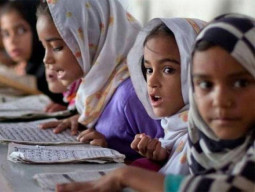
Teachers are central to teaching and learning process. Sustained interaction with quality teachers coupled with effective school management is important contributing factors to better learning outcomes (UNESCO, 2012).
Inadequate number of teaching staff irrevocably leads to high Student Teacher Ratio (STR). Smaller classes are more manageable for teachers and allow them more time to focus on students’ individual needs (OECD 2011)-global best practice suggests an STR of 25:1.
However, teacher shortage in the public education sector is undisputedly pronounced; currently 1,445,400 teachers are serving 40,065,100 students (UNESCO, 2013). 61,916 teachers are required in Punjab while 13,515 teachers are needed in Khyber-Pakhtunkhwa (ibid, 2013). 88,028 teachers are short in Sindh (SESP, 2015-18) while Balochistan has to recruit 9,726 primary school teachers to match the requirement (BESP, 2011-15). Overall, STR is highest in primary schools across the country: (39:1) in K-P, (30:1) in Sindh, (40:1) in Punjab and (1:21) in Balochistan .
Though the bulk of enrolment is in primary schools, many are understaffed in Pakistan- with only one classroom and a teacher available for five classes. 101 one-room primary schools in K-P accommodate 7,669 students with an STR of 70:1 for boys. 69 such primary girls schools, serve 4,446 students with an STR of 64:1 (KESP, 2010-11/2015-16). In Balochistan almost 55% of primary schools have a single teacher (BESP, 2013-17) whereas 8,920 one-room primary schools are available for primary school children in Sindh (SESP, 2014-18). The situation in Punjab is not too different—6615 primary schools have one teacher. STR in such schools is phenomenally high.
STR is usually calculated by dividing the total number of students with the total number of teachers available to serve them. However, this formula masks the number of students and teachers available per class. Though the STRs reported in ESPs seem high against the global best practice, these may be much higher in many primary schools where students have access to only one teacher who teach multi-grades-for which they may not be sufficiently trained.
To address this issue, teacher rationalisation is an important step that can provide accurate data about current allocation of teaching workforce and their qualifications to identify the need for additional teachers and in-service teacher trainings. Accordingly, this activity was viewed as a strategy to improve the education system in the national education policy 2009 and the subsequent Provincial Education Sector Plans.
In order to achieve the goal, all provinces have developed an EMIS system whereby data pertaining to schools and teachers is available to the provincial governments. The rationalisation exercise was completed in K-P, Punjab, AJK, G-B and the database was linked to existing EMIS system in AJK and G-B to ensure effective utilisation of resources, improve teacher deployment system, rationalise STR, etc. Based on the data, the provincial governments planned to rationalise and transfer teachers to schools that were understaffed.
The benefits of teacher rationalisation exercise are manifold. The first is that government’s scarce financial resources will be utilised efficiently because need-based transfers of excess staff can fill the vacant posts in schools where additional staff is required. Secondly, the human resource will be utilised optimally as the reallocated extra staff can use their time teaching in schools. Thirdly, with the help of accurate data the government can deploy need-based subject specialists in schools and streamline continuous professional development (CPD) for serving teachers. Lastly, the government can assess the number of vacant posts and recruit new teachers to address teacher-shortage in the system.
Teacher rationalisation is currently based on STR in all four provinces. Though rationalising and transferring teachers based on STR is a suitable and convenient strategy, there are several other school-specific factors that need to be taken into account—profile and quality of teachers; remaining years to retirement; proximity of schools; teaching performance etc, to ensure schools are not deprived of their best performing staff. Head teachers and teachers form a team to perform their duties in schools. Disrupting a competent team can have a serious adverse effect on school performance. Therefore it is important to preserve high-performing teams and plan transfers in consultation with head teachers.
In K-P, Sindh and Punjab, many teachers argue that the transfer process was not merit-based, lacked transparency and created substantial problems for teachers who were transferred to far-flung areas, making it difficult for teachers to reach their duty stations, especially for those who do not enjoy political clout.
Nevertheless, provincial governments are working towards the goal at their respective pace. They are trying to address teachers’ grievances and creating a balance between solving the issue of teacher shortage and adjusting the serving teaching workforce according to school requirements with some success. However, teachers, too, will have to sacrifice their comfort-zones in the best interest of children of Pakistan and understand that rationalisation, in the larger scheme of education reform, is a measure to improve the public education system. It can facilitate provincial governments to conduct teacher-mapping exercise and develop a projection model to forecast population, students enrollment and number of teachers needed at the district and provincial levels. This data can help make informed policy decisions.
Alternatively, school-based management is an option to be considered to improve schools. Decentralisation of teacher-recruitment to school level and strengthening head teachers’ role can resolve the issues efficiently. This strategy will help avoid delays in decision-making for need and merit based recruitment, encourage team-building in schools and place head teachers in a cental role to lead and control their teams. However, creating a separate cadre for school-management that is trained for the task and robust accountability system will be essential to benefit from school-based management.
Overall, teacher rationalisation is essential. Facilitating teachers to reach and attend schools conveniently is also crucial. Improvement in a system helps bring positive change only when it is merit-based and uniformly implemented with transparency, in its true spirit. However, the most important ingredient adversely affecting the education system is lack of true concern for children who attend government schools. The question is how are we going to inject the magic potion that can actually help us rise above our own interests and contribute positively in children’s lives?
Published in The Express Tribune, April 30th, 2015.









1721801554-0/BeFunky-collage]-(10)1721801554-0-270x192.webp)













COMMENTS
Comments are moderated and generally will be posted if they are on-topic and not abusive.
For more information, please see our Comments FAQ